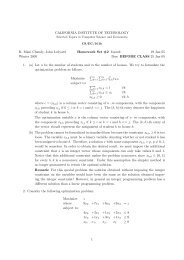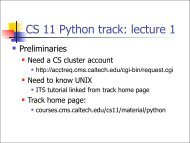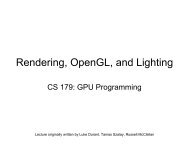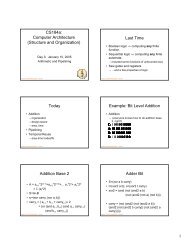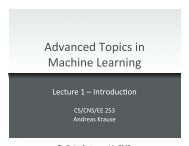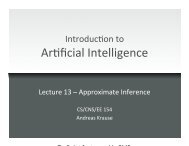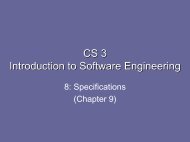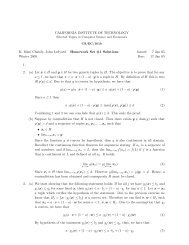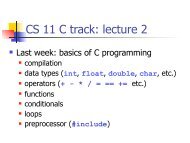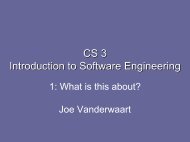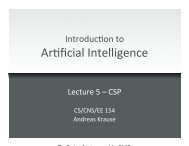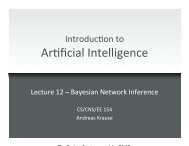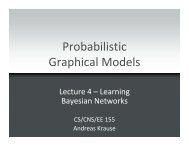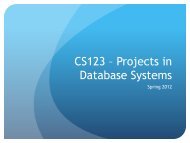You also want an ePaper? Increase the reach of your titles
YUMPU automatically turns print PDFs into web optimized ePapers that Google loves.
CALIFORNIA INSTITUTE OF TECHNOLOGY<br />
Selected Topics in Computer Science and Economics<br />
CS/EC/101b<br />
K. Mani Chandy, John Ledyard <strong>Homework</strong> Set #4 Issued: 15 Feb 05<br />
Winter 2005 Due: BEFORE CLASS 24 Feb 05<br />
1. Using Bayes rule we have<br />
Pr(coin = A| h heads) =<br />
Pr(h heads | coin = A) · Pr(coin = A)<br />
Pr(h heads)<br />
(1)<br />
Using the formula for the binomial coefficient to compute the probabilites above and using the<br />
data of the problem, we obtain<br />
After simplification, we obtain<br />
u ( )<br />
h+t<br />
h p h (1 − p) t<br />
u ( )<br />
h+t<br />
t p h (1 − p) t + (1 − u) ( ) (2)<br />
h+t q h (1 − q) t<br />
t<br />
u p h (1 − p) t<br />
u p h (1 − p) t + (1 − u) q h (1 − q) t (3)<br />
If q = 1 − p, then Pr(coin = A| h heads) in equation 3 becomes<br />
We can then rewrite the expression as<br />
u p h (1 − p) t<br />
u p h (1 − p) t + (1 − u) (1 − p) h p t (4)<br />
u p h (1 − p) t<br />
p h (1 − p) t [u + (1 − u) p t−h (1 − p) h−t ]<br />
(5)<br />
and after further simplification we obtain<br />
u<br />
[u + (1 − u) p t−h (1 − p) h−t ]<br />
(6)<br />
A similar calculation can be done for computing Pr(coin = B| h heads). After doing it, we<br />
obtain<br />
u<br />
[u + (1 − u) (1 − p) t−h p h−t ]<br />
(7)<br />
(i.) No, I would not buy the information
(ii.) In order to compute the conditional probability of A given the experimental outcome ”h<br />
heads and t tails”, we only need to know the difference h − t, as it clearly appears from<br />
the formula in equations 6 and 7. Therefore, knowing the exact number of heads and<br />
tails in the experiment does not add any additional value.<br />
(iii.) For any value of u, we can easily verify that Pr(A|x) > Pr(B|x) iff<br />
( ) 1 − p t−h ( ) 1 − p h−t<br />
><br />
(8)<br />
The expression 8 can be rewritten as<br />
p<br />
p<br />
(1 − p) 2h−2t > p 2h−2t (9)<br />
Since we are assuming p > 0.5 I would call head if 2h − 2t > 0, i.e. the number of heads<br />
is larger than the number of tails.<br />
(iv.) Yes, the answer to the previous questions would change. In the case when p ≠ q the<br />
probability of the next toss being h and t will depend on on the exact values of h and t<br />
and not only on their difference. Since the cost of the information is only one, one can<br />
easily check the expected profit after buying the information is higher than the expected<br />
profit without using any information.<br />
(v.) In the case when q = 1 − p and u ≠ 0.5, the answer to first three previous questions<br />
does not change. The reason is that the criteria to decide if Pr(head|A) > P r(head|B) is<br />
independent of u as it clearly appears from equation 9.<br />
2. (a) The curve for the cost and utility functions is shown in figure 1:<br />
Let u 1 (c) = 16 log(C) and u 2 (c) = 36 log(c). Furthermore, let f(c) = x 1 + x 2 = 2c + 14c 2<br />
Picture 1 shows that the maximum M C of the concave function u 2 (c) − f(c) is larger<br />
than the maximum m c of the concave function u 1 (c) − f(c). Therefore, knowing that<br />
Computer Science is going to buy M c units of capacity there will be no incentive to buy<br />
capacity for Economics. The consequence is that x 1 = 0. In order to find the price x 2<br />
payed by Economics we have to determine c such that ∂u 2<br />
c<br />
= ∂f c<br />
. This follows from the<br />
fact that the function 36 log(c) − (2c + 14c 2 ) is concave. This equals to solving the second<br />
order equation 14c 2 + c − 18 = 0 which implies c = 1.0987. Substituting this value into<br />
the expression x 2 = 2c + 14c 2 , we obtain that x 2 = 19.0987.<br />
(b) If <strong>Caltech</strong> is paying the entire amount, then <strong>Caltech</strong> will assign the capacity c which<br />
maximizes the concave function<br />
(16 + 36) log(c) − (2c + 14c 2 ) (10)<br />
Using the first order condition, we obtain that 14c 2 + c − 26 = 0, which implies c ∗ =<br />
1.328. The price paid by <strong>Caltech</strong> is obtained plugging the value of c into the expression<br />
x = B ·c+D ·c 2 . After doing that, the value x = 27.32 is obtained. Such value represents<br />
the entire amount of money paid by <strong>Caltech</strong> for the pipe.<br />
2
140<br />
120<br />
cost<br />
Utility of Economics<br />
Utility of Computer Science<br />
100<br />
utility/cost<br />
80<br />
60<br />
40<br />
20<br />
0<br />
1 1.5 2 2.5 3<br />
capacity<br />
Figure 1: Cost and Utility functions<br />
(c) Yes, there is a difference. A larger amount of capacity is paid by CalTech when trying<br />
to maximize its total utility minus costs. In part A the Economics Department is not<br />
paying any money and it is benefiting from knowing that Computer Science will buy<br />
enough capacity for it too. In economic terms, we say that the Economic department<br />
free rides.<br />
(d) The Lindhal prices are q 1 = a 1 /c ∗ and a 2 = c ∗ . After the appropriate subsitution, we<br />
obtain q 1 = 12.053 and q 2 = 27.18. It can be verified that this fulfills the equation<br />
q 1 + q 2 = B + 2DC, where the right hand side is the derivative of the cost function and B<br />
and D are known parameters of the problem. So, if <strong>Caltech</strong> decides to charge the price q i<br />
for Department i, then the optimal capacity to buy for both department will be exactly<br />
c ∗ .<br />
3



